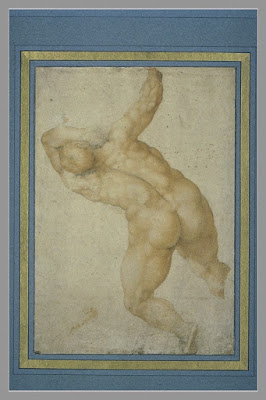 |
| Anonymous Italian Copyist after Michelangelo Prophet Jonah (Sistine Ceiling) 16th century drawing Musée du Louvre |
 |
| Anonymous Italian Copyist after Michelangelo Libyan Sibyl (Sistine Ceiling) 16th century drawing Musée du Louvre |
 |
| Anonymous Italian Copyist after Michelangelo Salathiel and his Mother (Sistine Ceiling) 16th century drawing Musée du Louvre |
 |
| Anonymous Italian Copyist after Michelangelo Ignudo (Sistine Ceiling) 16th century drawing Musée du Louvre |
 |
| Anonymous Italian Copyist after Michelangelo Ignudo (Sistine Ceiling) 16th century drawing Musée du Louvre |
 |
| Anonymous Italian Copyist after Michelangelo Ignudo (Sistine Ceiling) 16th century drawing Musée du Louvre |
 |
| Anonymous Italian Copyist after Michelangelo Ignudo (Sistine Ceiling) 16th century drawing Musée du Louvre |
 |
| Anonymous Italian Copyist after Michelangelo Risen Man (Last Judgment fresco, Sistine Chapel) 16th century drawing Musée du Louvre |
 |
| Anonymous Italian Copyist after Michelangelo Risen Man (Last Judgment fresco, Sistine Chapel) 16th century drawing Musée du Louvre |
 |
| Anonymous Italian Copyist after Michelangelo Damned Soul (Last Judgment fresco, Sistine Chapel) 16th century drawing Musée du Louvre |
 |
| Anonymous Italian Copyist after Michelangelo Statue of Dawn (Tomb of Lorenzo de' Medici) 16th century drawing Musée du Louvre |
 |
| Anonymous Italian Copyist after Michelangelo Statue of Night (Tomb of Giuliano de' Medici) 16th century drawing Musée du Louvre |
 |
| Anonymous Italian Copyist after Michelangelo Study of Statue, possibly Belvedere Torso (copy of lost drawing) 16th century drawing Musée du Louvre |
 |
| Anonymous Italian Copyist after Michelangelo Two Figures from the Battle of Cascina (copy of lost drawing) 16th century drawing Musée du Louvre |
 |
| Anonymous Italian Copyist after Michelangelo Figure Study (copy of lost drawing) 16th century drawing Musée du Louvre |
"An older view of Mannerism . . . conceived of it as the style of the imitators of Michelangelo. That view is no longer valid, even for the styl of Maniera proper, but it reminds us of the role of Michelangelo in relation to the whole style as we now chronologically define it. He was the greatest living power in art, and contemporary style took significant aspects of example from him. . . . Even when he drew or painted Michelangelo's example remained essentially sculptural, and in Florence the force of this example on painters came to displace to a great extent the mode that had its origin in the style of Leonardo, and its culmination in the painterly exercises of Andrea del Sarto. It was Michelangelesque classicism, far more than Andrea's, that had a continuing validity as a term of reference for the Florentine Mannerist style."
– S.J. Freedberg, Painting in Italy, 1500-1600 (Pelican History of Art), 1970